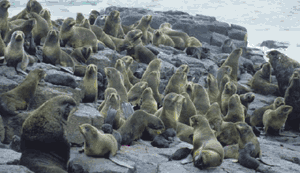 Age and sex classes of northern fur seals have been counted regularly on the Pribilof Islands during the 20th century. Estimates of the Pribilof Islands fur seal population recorded prior to 1900 are suspect due to methodology. Numbers of northern fur seals are counted or estimated during the summer breeding season when the majority of the population is on land at some time during this period.
Age and sex classes of northern fur seals have been counted regularly on the Pribilof Islands during the 20th century. Estimates of the Pribilof Islands fur seal population recorded prior to 1900 are suspect due to methodology. Numbers of northern fur seals are counted or estimated during the summer breeding season when the majority of the population is on land at some time during this period.
Adult male seals have been counted annually since 1909 with the exception of a few years when research was redirected or interrupted by war. Breeding-age males are a consistent component of the fur seal population to assess because they stay on shore in predictable locations for a definitive period of time. Also, physical size and number of breeding males are conducive to direct counts and adult male classifications have been consistent with very few changes since 1909.
Direct counts of fur seal pups were conducted on all rookeries from 1912 through 1916. As the population grew beyond the means of direct counts, sample rookeries were counted from 1917 to 1921. On all other rookeries, the average number of females in a territory was used to estimate pup production. Pups were again counted on all rookeries in 1922 to validate the estimation procedure of prior years. An average increase per year in the number of females in a territory was computed from the two direct pup counts done in 1916 and 1922. This increase was applied to the number of females in a territory in 1924 to estimate number of pups in 1925. This method was used to estimate pup production from 1925 until 1941. As the herd continued to increase, it was believed that the calculated growth rate (approximately 8%) could not be sustained due to several factors including increased competition and increased mortality due to disease. A 7% increase was applied from 1942 to 1946, and a 6% increase was applied in 1947. More details on the estimation procedures from 1912 to 1947 can be found in Kenyon et al. (1954).
As a basis for mark-recapture estimates of pup production and survival on the Pribilof Islands, fur seal pups were marked with flipper tags from 1947 to 1949 and from 1952 to 1968. Tags were recovered from animals during the commercial harvest. Though a 3-year time lag between tagging and recovery delayed results, pup production estimates from tag recoveries were thought to be the most objective of several techniques tried at that time (Kenyon et al. 1954). However, an analysis in the mid 1950s suggested tagging estimates were unreliable (Chapman 1958, 1964). Also, it was determined optimal to estimate a given year’s cohort strength in the year of its birth.
Starting in 1960, more sophisticated mark-recapture studies were developed to estimate pup production. Experimenting with different marks and tags continued, and in 1963 the method of shearing a small patch of guard hair from the pup’s head to expose the light underfur was instituted. This method made it logistically possible to distribute marks throughout all rookeries. In 1965, rookeries were subdivided into smaller units based on the number of breeding males to better distribute marks (Chapman et al. 1968). Shear-sampling estimates of pup production proved superior but depended on sampling all rookeries.
Shear-sampling every rookery on the Pribilof Islands is labor intensive and disruptive to rookeries during a critical time in pup rearing. Methods were developed to estimate pup production for the island of St. Paul, largest of the Pribilof Islands, based on shear-sampling a few rookeries (York and Kozloff 1987). This method took advantage of the strong relationship between breeding males and numbers of pups on rookeries and is still in use. Shear-sampling all rookeries resumed in 1990 due to the uncertainty of the estimate of pups born in 1989 (Antonelis et al. 1990). All rookeries on St. Paul Island were shear-sampled in 1990, 1992 and 1994. In 1996 we returned to sub-sampling rookeries on St. Paul Island (York and Towell 1997).

